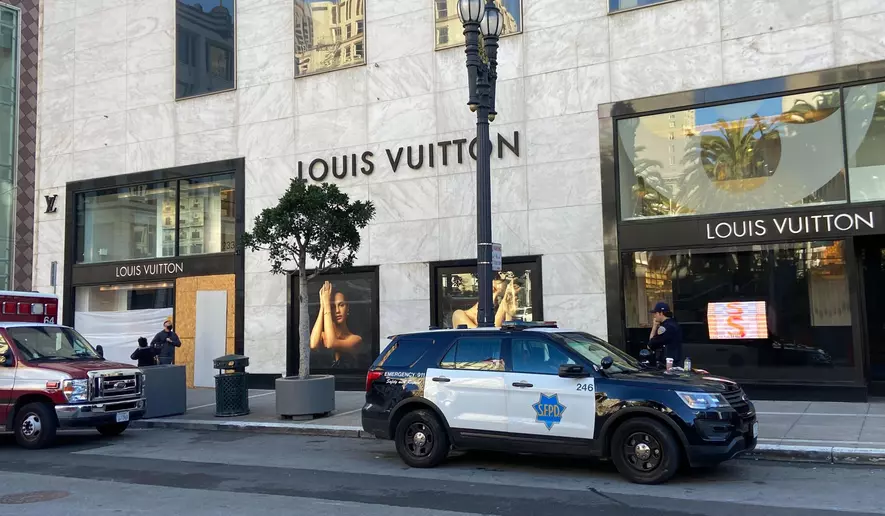Chander Sheikher still has nightmares about three men pointing guns in his face at a Connecticut jewelry shop while they smashed display cases and beat the elderly owner.
“It shook me up and I’m still taking meds,” Mr. Sheikher, the manager of ABC Jewelry, told The Washington Times in a phone call Monday. “We put on safety glass and got a security guard, too, which is the only thing making me feel a little more protected right now.”
Mr. Sheikher recently returned to work at the store in Bridgeport, where a judge sentenced 32-year-old assailant Adam Buster to seven years in prison and five years of probation Wednesday for his role in the June 10, 2023, incident.
He is one of thousands of Americans victimized annually by violent crimes at retail stores. Only a handful ever see their attackers end up in jail.
Recent industry reports suggest staffing shortages, urban shoplifting trends and soft-on-crime policies have contributed to rising prices and a growing perception of danger among brick-and-mortar shoppers.
Nationally, Capital One recently estimated that retail theft losses will swell from $121.6 billion last year to over $150 billion by 2026. It noted that stores catch shoplifters 2% of the time, with police arresting the average offender just once out of every 100 incidents.
“Recent data shows that while overall crime rates have fallen in 2024 across 39 major cities, rates of retail crime have spiked,” said Tom Wickham, vice president of government affairs at the U.S. Chamber of Commerce, a business lobbying group. “This makes it more crucial than ever that we work together to find solutions supporting businesses and providing a safe shopping environment for everyone.”Mr. Wickham said companies have faced “unprecedented challenges” in hiring workers as the trend worsens.
In a digital survey of 613 consumers that market researcher Premise conducted Thursday-Friday, 44% agreed with the statement, “Violent crime at physical retail stores has increased in recent years.”
That came after Texas-based communication platform Theatro reported that 78% of consumers responding to a recent survey feared for their safety and security while shopping in person at stores. Nearly half expressed frustration that understaffing makes them feel less protected from theft and violence.
Theatro makes a wearable device that retailers give their employees to report thefts and other safety issues as they unfold.“Understaffing increases the opportunity for theft and violence because there’s no one to call for help,” said Kimberley Drobny, Theatro’s chief marketing officer. “You’re starting to see everything from chapstick to lotion locked up at stores in places like California and Colorado, and it creates an uneasiness about where you’re shopping. You wouldn’t have to do that if it was a safe place to shop.”
Paying for crime
Job openings nationwide number 8 million, with just 6.8 million unemployed workers available to fill them.
“Retail stores are experiencing staffing shortages because they now have to pay their entry-level workers combat pay to survive on the job,” said Andrew Crapuchettes, CEO of Idaho-based jobs board RedBalloon. “To boot, in-person stores just don’t have the revenue to afford better security and higher wages.”
According to the FBI, which doesn’t report retail numbers separately, violent crime dropped by 10.3% nationwide in the first six months of 2024.In a statement emailed to The Washington Times, the bureau nevertheless said it was aware of industry reports that organized gangs of shoplifters have become more violent since the pandemic.
“We prioritize efforts to combat it by working with our law enforcement partners at all levels to identify these organizations, dismantle them using an enterprise theory of investigation, and employ sophisticated investigative techniques,” the FBI said.
California has become ground zero in the struggle, as hundreds of crime-ravaged stores have closed in urban centers such as San Francisco the past few years.
According to Democratic Gov. Gavin Newsom, the California Highway Patrol netted 106% more arrests for organized retail thefts in July than in June. He said 128 investigations led to the arrests of 167 suspects.
“The state’s Organized Retail Crime Task Force is responding readily and at record pace to crack down on organized criminals attempting to rip off California’s storefronts — demonstrating a continued commitment to enforcing public safety and protecting our communities,” Mr. Newsom said in August.Christopher Tang, a UCLA business professor, said high-profile arrests and recent policy changes have failed to reassure shoppers or stem a rising tide of violent incidents at stores and malls.
“We need stiffer penalties and we need stronger law enforcement,” Mr. Tang said. “And we need more security in public places.”
He said high-profile shootings at shopping malls, throngs of mentally unstable homeless people near stores, smash-and-grab robberies, weak shoplifting laws and minimal jail sentences for offenders have all helped scare off shoppers.
Under California law, the theft of goods valued at $950 or less is a misdemeanor — and shoplifters can be prosecuted for federal theft crimes only if they steal goods worth more than $5,000 in a single heist.
“On top of that, the law enforcement is weakened since the Black Lives Matter movement, and police need to tread more gently,” Mr. Tang added. “These fears are real.”Retailers have instructed their employees to ignore thefts in recent years, opting to absorb financial losses rather than risk the financial liability of a violent conflict.
Nelo Lucich, CEO of the tech toy company Skyrocket, said the theft of small, high-priced items has become “a constant part of the retail landscape” at stores.
Last month, the National Retail Federation sponsored a letter that 211 retailers sent to congressional leaders urging them to establish a center to coordinate federal, state and local law enforcement efforts to curb retail theft. The signatories included Walmart, Target, Walgreens and dozens of small businesses.
NRF spokeswoman Mary McGinty said rampant shoplifting has persisted even as retailers add security guards, cameras and loss-prevention gadgets.
Her advocacy group reported that 57% of consumers responding to a recent survey expected to make holiday purchases online this year compared with fewer than half who planned to shop at brick-and-mortar locations.“We know from speaking with our members as well as conducting NRF research in the space that safety and security are a top priority for retailers,” Ms. McGinty said in an email.
Soft on crime
Retail thefts started rising during COVID-19 lockdowns, with reports of increased looting in stores and violent incidents in depopulated shopping centers.
According to economists, efforts to combat the trend through task forces and enhanced store security have proved largely ineffective.
“States like California have worsened the situation by reducing the crimes to misdemeanors,” said Daniel Lacalle, a professor of global economics at IE Business School in Spain. “Some retailers have invested significant amounts in private security, but the inflation spike has made it difficult for most, as costs have soared.”
Peter C. Earle, an economist at the free-market American Institute for Economic Research, said another problem is public officials minimizing or ignoring the problem. He pointed to estimates that shoplifting incidents rose 10% in the first half of 2024 from the same period in 2019.“Two of the issues voters have indicated as among their major concerns in the coming election are inflation and crime,“ Mr. Earle said. “In both cases, government officials are telling U.S. citizens not to believe their eyes, but rather what they’re being told.”
• Sean Salai can be reached at ssalai@washingtontimes.com.

